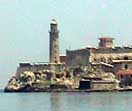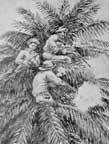
|
Read about Cuban history, from before the 16th century, when Cuba was inhabited by indigenous peoples, up to the present day. The last few centuries, from the 16th to the 20th, features articles about numerous important events. Interactively explore the island's history using our Java-based timeline.
During the 16th and 17th centuries, Cuba was almost exclusively dominated by Spanish colonial rule. Cuba acted as a hub of commerce between Europe and the New World. Accordingly, the slave trade through Cuba grew rapidly, ending only in the 1800s. The indigenous population was all but decimated by murder, starvation, slavery, and European diseases. The 18th century saw significant development in Cuba's economy and infrastructure. It was during this time th  at Spain began to develop Cuba's natural resources rather than just treating the island as a trading station. The only major break in Spanish prosperity during this time was the British occupation of Havana.
The 19th century was a time of gradual decline for the Spanish in Cuba. Facing increased resistance from Cuban revolutionaries, Spanish authority eroded over the course of this century.
From the turn of the century to the present day, the 20th century has been a time of many changes in Cuba. With a new threat to true independence emerging in American imperialism, the Cuban struggle must have seemed to be a lost cause at times. Finally, with a stable government under Castro in place, Cubans can enjoy basic improvements in their standard of living. at Spain began to develop Cuba's natural resources rather than just treating the island as a trading station. The only major break in Spanish prosperity during this time was the British occupation of Havana.
The 19th century was a time of gradual decline for the Spanish in Cuba. Facing increased resistance from Cuban revolutionaries, Spanish authority eroded over the course of this century.
From the turn of the century to the present day, the 20th century has been a time of many changes in Cuba. With a new threat to true independence emerging in American imperialism, the Cuban struggle must have seemed to be a lost cause at times. Finally, with a stable government under Castro in place, Cubans can enjoy basic improvements in their standard of living. |

|
| |
|
Home |
Overview About | Culture | Current Events Forums | Further info | History People | Places | Politics | Search Simulations | Travel | |
|
Historical Events - List Historical Events - Timeline Before the 1500s 16th and 17th Centuries 18th Century 19th Century 20th Century | |
